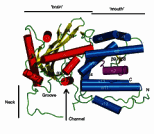Scientists and researchers have taken a big step closer to a cure for the most common strain of avian influenza, or “bird flu,” the potential pandemic that has claimed more than 200 lives and infected nearly 400 people in 14 countries since it was identified in 2003.
Researchers at the U.S. Department of Energy's (DOE’s) Argonne National Laboratory, in conjunction with scientists from China and Singapore, have crystallized and characterized the structure of one of the most important protein complexes of the H5N1 virus, the most common strain of bird flu.
All viruses, including H5N1, contain only a small number of proteins that govern all of the viruses' functions. In H5N1, perhaps the most important of these proteins is RNA polymerase, which contains the instructions that allows the virus to copy itself along with all of its genetic material. The Argonne study focused on H5N1's RNA polymerase protein, which contains three subunits: PA, PB1 and PB2.
After performing x-ray crystallography on the protein crystals at Argonne Structural Biology Center beamline 19-ID-D at the Advanced Photon Source, the researchers saw a surprising resemblance in the protein structure's image. “When we mapped out the PA subunit, it looked very much like the head of a dragon,” said Argonne biophysicist Andrzej Joachimiak. “One domain looked like the dragon's brains, and the other looked like its mouth.”
During RNA replication – the phase during which the virus “reproduces” – all three of the subunits of the protein assemble themselves in a particular configuration. In order for this congregation to take place, the researchers determined the end of the PB1 subunit has to insert itself and bind to the “dragon's mouth” part of the PA subunit.
This unexpected relationship between the two subunits could inspire a number of different therapies or vaccines for H5N1 that rely on muzzling the “dragon's“ jaws with another molecule or chemical compound that would block the PB1 subunit's access to the PA site, according to Joachimiak. “If we can put a bit in the dragon's mouth, we can slow or even potentially someday stop the spread of avian flu,” he said. “Since we are talking about a relatively small protein surface area, finding a way to inhibit RNA replication in H5N1 seems very feasible.”
Joachimiak hopes to more precisely identify the types of compounds that could inhibit RNA replication in H5N1 by looking at the atomic-level grooves and pockets within the PA “mouth“ region. According to Joachimiak, scientists must gain a more thorough understanding of the geometry of that small region in order to effectively synthesize drugs that could prevent the further spread of bird flu.
Argonne researchers Joachimiak and Rongguang Zhang collaborated with Zihe Rao and Yingfang Liu, both members of the Institute of Biophysics of Chinese Academy of Sciences. Rao is one of the most influential Chinese crystallographers and biophysicists, Joachimiak said. The protein samples were manufactured in China and crystals were shipped to Argonne for data collection and structural analysis.
– Jared Sagoff
See: Xiaojing He, Jie Zhou, Mark Bartlam, Rongguang Zhang, Jianyuan Ma, Zhiyong Lou, Xuemei Li, Jingjing Li, Andrzej Joachimiak, Zonghao Zeng, Ruowen Ge, Zihe Rao, and Yingfang Liu, “Crystal structure of the polymerase PAC–PB1N complex from an avian influenza H5N1 virus,” Nature 454, 1123 (28 August 2008). DOI10.1038/nature07120
Contact: Zihe Rao (raozh@xtal.tsinghua.edu.cn) and Yingfang Liu (liuy@ibp.ac.cn
This work was funded by the National Natural Science Foundation of China as well as the Chinese Ministry of Science and Technology and the U.S. Department of Energy's Office of Biological and Environmental Research. Use of the Advanced Photon Source at Argonne National Laboratory was supported by the U. S. Department of Energy, Office of Science, Office of Basic Energy Sciences, under Contract No. DE-AC02-06CH11357.
The original press release is at: http://www.anl.gov/Media_Center/News/2008/news080715.html
Argonne National Laboratory brings the world's brightest scientists and engineers together to find exciting and creative new solutions to pressing national problems in science and technology. The nation's first national laboratory, Argonne conducts leading-edge basic and applied scientific research in virtually every scientific discipline. Argonne researchers work closely with researchers from hundreds of companies, universities, and federal, state and municipal agencies to help them solve their specific problems, advance America 's scientific leadership and prepare the nation for a better future. With employees from more than 60 nations, Argonne is managed by UChicago Argonne, LLC for the U.S. Department of Energy's Office of Science.

